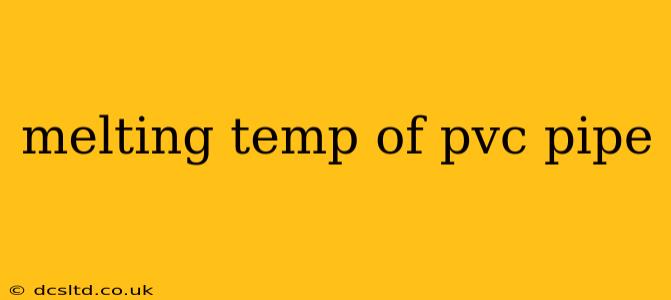Polyvinyl chloride (PVC) pipe is a ubiquitous material used in various applications, from plumbing and drainage to electrical conduit and industrial processes. Understanding its melting point is crucial for safe handling, processing, and application. However, it's important to clarify that PVC doesn't have a single, sharply defined melting point like some materials. Instead, it undergoes a softening and degradation process over a temperature range. This guide will explore the thermal behavior of PVC pipe and answer common questions surrounding its melting point.
What is the melting point of PVC pipe?
There's no single definitive melting point for PVC pipe. Instead, PVC softens and degrades over a temperature range, typically beginning around 130-150°C (266-302°F). At these temperatures, the polymer chains begin to weaken and the material becomes pliable. Further increases in temperature lead to significant degradation, with the PVC breaking down and emitting harmful fumes. Complete melting and decomposition usually occur above 200°C (392°F). The exact temperature at which these changes occur can vary slightly depending on factors like the specific formulation of the PVC (additives and plasticizers), the pipe's thickness, and the duration of exposure to heat.
Does the color of the PVC pipe affect its melting point?
The color of PVC pipe generally does not significantly affect its melting point. The color is typically achieved through the addition of pigments, which are present in relatively small quantities compared to the PVC polymer itself. While some pigments might have a minor influence on the thermal properties, the effect is usually negligible compared to other factors like the PVC formulation and pipe thickness.
What happens when PVC pipe melts?
When PVC pipe is heated to its softening and degradation temperatures, several things occur:
- Softening: Initially, the PVC becomes pliable and loses its rigidity. This is the temperature range most relevant to pipe bending or shaping.
- Decomposition: At higher temperatures, PVC starts to decompose, releasing hydrogen chloride (HCl) gas and other volatile organic compounds (VOCs). These gases are toxic and can be harmful if inhaled.
- Burning: At even higher temperatures, PVC can ignite and burn, releasing more toxic fumes and smoke.
It is crucial to understand that melting PVC pipe should only be attempted by trained professionals using appropriate safety precautions, including proper ventilation and personal protective equipment (PPE).
What is the softening point of PVC pipe?
The softening point of PVC pipe is typically within the range of 130-150°C (266-302°F). At this point, the material becomes malleable enough for applications like bending the pipe for installation. It's important to note that prolonged exposure to temperatures within this range can still lead to gradual degradation of the material.
How does the thickness of PVC pipe affect its melting point?
Thicker PVC pipes generally take longer to heat up and cool down compared to thinner ones. This means that while the melting point itself isn't significantly affected by thickness, the time it takes to reach that temperature and the overall thermal response will be different. Thicker pipes may require higher temperatures or longer exposure times to reach the softening point.
Can PVC pipe be recycled?
Yes, PVC pipe can be recycled, although the processes are more complex than for some other materials. Specialized recycling facilities are needed to handle PVC due to the presence of chlorine and the need to avoid releasing harmful byproducts. The recyclability of PVC pipe often depends on the local infrastructure and available recycling programs.
This comprehensive guide provides a detailed understanding of the melting temperature of PVC pipe and related crucial aspects. Remember that working with heated PVC requires caution and safety measures to avoid potential health hazards. Always consult safety data sheets (SDS) for specific PVC formulations and follow recommended safety procedures.
